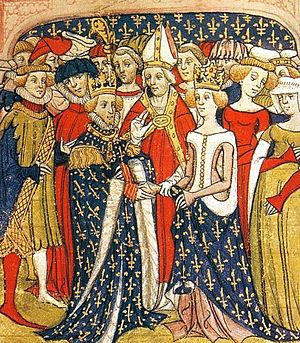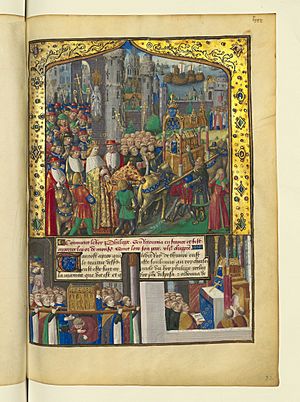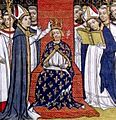Philip III of France facts for kids
Quick facts for kids Philip III |
|
|---|---|

Coronation of King Philip III
|
|
| King of France (more...) | |
| Reign | 25 August 1270 – 5 October 1285 |
| Coronation | 15 August 1271 |
| Predecessor | Louis IX |
| Successor | Philip IV |
| Born | 1 May 1245 Poissy |
| Died | 5 October 1285 (aged 40) Perpignan |
| Burial | Initially Narbonne, later Saint Denis Basilica |
| Spouse | |
| Issue |
|
| House | Capet |
| Father | Louis IX of France |
| Mother | Margaret of Provence |
Philip III (born May 1, 1245 – died October 5, 1285) was known as "the Bold" (which means le Hardi in French). He was the King of France from 1270 until his death.
Philip became king when his father, King Louis IX, died in Tunis during a big religious war called the Eighth Crusade. Philip was with his father at the time. After his father's death, Philip went back to France and was crowned king in 1271.
During his time as king, Philip gained a lot of new land for France. One important area was the County of Toulouse, which became part of the royal lands in 1271. He also made France more powerful in the Kingdom of Navarre. When his brother Peter died, another area called County of Alençon also became part of the royal lands.
Later, Philip led a war called the Aragonese Crusade. This war was to support his uncle. At first, things went well, but then many of Philip's soldiers got sick. He had to retreat and sadly died from an illness in 1285. His son, Philip IV, became the next king.
Contents
Early Life of Philip III
Philip was born in Poissy, France, on May 1, 1245. He was the second son of King Louis IX of France and Margaret of Provence. Because he had an older brother named Louis, Philip was not expected to become king.
However, his older brother Louis died in 1260. This meant Philip became the next in line for the throne.
Philip's mother, Margaret, made him promise to stay under her guidance until he was 30 years old. But Pope Urban IV released him from this promise in 1263. After that, Pierre de la Broce, a trusted helper of King Louis IX, became Philip's main teacher. His father, Louis, also gave him advice, especially about how important justice was for a king.
In 1262, Philip married Isabella of Aragon. This marriage was part of a peace agreement between France and Aragon.
Becoming King During the Crusade
In 1270, Philip went with his father, King Louis IX, on the Eighth Crusade to Tunis. Before leaving, King Louis put Mathieu de Vendôme and Simon II, Count of Clermont, in charge of France.
After the French army captured the city of Carthage, a serious illness spread through the camp. Many soldiers, including Philip and his family, got sick. Philip's brother, John Tristan, Count of Valois, died first. Then, on August 25, King Louis IX died. To bring the king's body back to France, it was prepared in a special way for the long journey.
Philip, who was only 25 and also sick, was declared the new king in Tunis. His uncle, Charles I of Naples, made a peace deal with the ruler of Tunis. This agreement was signed in November 1270.
More sad deaths followed. In December, Philip's brother-in-law, King Theobald II of Navarre, died. In February, Philip's wife, Isabella, died after falling from her horse while pregnant. In April, Philip's sister, Isabella, also died.
Philip III finally arrived in Paris on May 21, 1271. He honored those who had died. The next day, his father's funeral was held. Philip was officially crowned King of France in Reims on August 15, 1271.
Philip's Reign
As king, Philip mostly continued the policies his father had set. He made sure that rules against fighting between powerful lords were followed. He also continued his father's rules about Jewish people in France. For example, he made them wear special badges. In 1283, he banned building or fixing Jewish places of worship and cemeteries.
In 1271, Philip's uncle, Alphonse, Count of Poitiers and Toulouse, died without children. Philip inherited his uncle's lands, including parts of Auvergne and Agenais. These lands became part of the royal domain, meaning they belonged directly to the king. However, a few years later, Philip gave Agenais back to the English king, Edward I, as part of a treaty.
Philip also had to deal with some rebellious nobles. In 1272, Roger-Bernard III, Count of Foix, attacked some royal officials. Philip led his army to the County of Foix and forced Roger-Bernard to surrender. Philip put him in prison for a year, but then released him and gave him back his lands.
In 1274, King Henry I of Navarre died, leaving his young daughter, Joan, as the heir. Other kings, like Alfonso X of Castile, tried to claim Navarre for themselves.
Joan's mother, Blanche of Artois, asked her cousin, King Philip, for help. Philip saw this as a chance to gain more land for France. In 1275, Philip and Blanche signed the Treaty of Orléans. This treaty arranged for one of Philip's sons to marry Joan. It also meant that Navarre would be managed from Paris by French officials.
Many people in Navarre were not happy with this French control. They started to rebel. In 1276, Philip sent an army to Navarre to calm the situation. The rebellion was quickly stopped, but it took until 1277 for the kingdoms of Castile and Aragon to give up their claims to Navarre.
The Sicilian Vespers and Philip's Death
In 1282, King Peter III of Aragon invaded Sicily. This started a rebellion called the Sicilian Vespers against Philip's uncle, King Charles I of Naples. Peter became king of Sicily. Pope Martin IV was very angry and took away Peter's kingdom, giving it to Philip's son, Charles, Count of Valois. Philip's brother, Peter, also died during this conflict.

Philip, encouraged by his wife, Marie of Brabant, and his uncle, Charles of Naples, started a war against Aragon. This war was called the "Aragonese Crusade" because the Pope supported it. However, some historians later called it a very unfair and costly war for France.
Philip led a large army into Aragon. By June 1285, he was attacking the city of Girona. Despite strong resistance, Philip captured Girona in September 1285.
Soon after, an illness spread through the French army, and Philip himself became very sick. The French army began to retreat. During the retreat, the Aragonese attacked them. Philip died from the illness in Perpignan on October 5, 1285. His son, Philip IV, became the new King of France. Philip III's body was prepared in a special way for burial in different places. His bones were buried at the Basilica of St Denis near Paris.
Family and Children
On May 28, 1262, Philip married Isabella, who was the daughter of King James I of Aragon. They had the following children:
- Louis (1264 – May 1276)
- Philip IV (1268 – November 29, 1314), who became the next King of France. He married Joan I of Navarre.
- Robert (1269–1271)
- Charles, Count of Valois (March 12, 1270 – December 16, 1325). He became Count of Valois. He married three times.
- A son who was stillborn (1271)
After Queen Isabella died, Philip married Marie, daughter of Henry III, Duke of Brabant, on August 21, 1274. Their children were:
- Louis, Count of Évreux (May 1276 – May 19, 1319). He became Count of Évreux.
- Blanche of France, Duchess of Austria (1278 – March 19, 1305). She married Rudolf I, who later became King of Bohemia and Poland.
- Margaret of France, Queen of England (1282 – February 14, 1318). She married King Edward I of England.
Philip's Legacy
During Philip's time as king, the lands controlled by the French crown grew larger. He gained the County of Guînes, the County of Toulouse, the County of Alençon, and the Duchy of Auvergne. Also, through his son Philip's marriage, the Kingdom of Navarre became closely linked to France.
Philip mostly continued the good work of his father and kept his father's trusted advisors. However, his war to conquer Aragon cost a lot of money. This caused financial problems for the next king.
Review from Dante
The famous Italian poet Dante, in his poem Divine Comedy, imagined Philip III in a place outside of Purgatory. Dante didn't call Philip by name, but he described him as "the small-nosed" and "the father of the Pest of France." This last part was a reference to Philip's son, King Philip IV.
Images for kids
|
Philip III of France
Born: 1 May 1245 Died: 5 October 1285 |
||
| Regnal titles | ||
|---|---|---|
| Preceded by Louis IX |
King of France 25 August 1270 – 5 October 1285 |
Succeeded by Philip IV |
See also
 In Spanish: Felipe III de Francia para niños
In Spanish: Felipe III de Francia para niños





